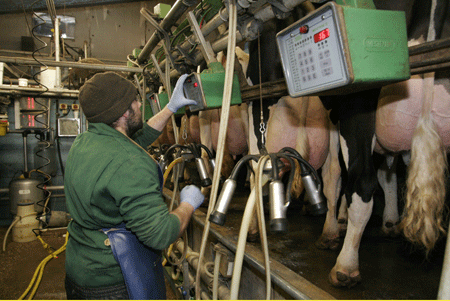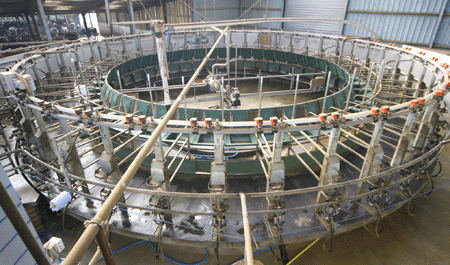In parlour feeding returns to popularity

There is a noticeable swing back to feeding in-parlour. But the days of dust, dallying cows looking in mangers and vermin attracted by stale cake have disappeared. Instead, feeding in-parlour has adapted to suit 21st-century management systems.
At one end of the scale, simple sow feeders operated by a single pull are proving a cost-effective addition to New Zealand-style basic parlours. At the other, modern parlour feeding has become fully computerised and automatic, linking to integrated management systems which relate feed rates to production and farm feed strategies.
Feeding in-parlour fell out of fashion when dairy hygiene rules pushed for cleanliness in food-producing environments to cut down on dust and vermin. In addition, some producers realised that feeding in-parlour wasn’t a pre-requisite for milk letdown. Others chose to feed outside for quieter cows and less manure at milking, while the big swing towards making more use of grazed grass steered away from routine concentrate feeding altogether.

But as most things turn full circle, rising concentrate costs and a need to supplement grazing, or complement forages, has seen a return to a traditional practice. Feeding concentrates in the parlour is easy to adjust on a daily basis. The substitution effect with grass is lower, and it allows energy to be targeted at high-yielding cows or those needing a boost for fertility.
Fullwood’s technical director John Baines confirms the growing trend towards installing in-parlour feeders. “Partly as more people realise the importance of individual cow precision management,” he says. “Although TMR is popular, many British herds are not big enough to closely match nutrition, so some cows are underfed, others are over fed.”
Many low-cost producers have tried the Kiwi way of feeding concentrates in the paddock, yet found it led to more waste. They have also realised that while the aim is to treat cows as one mob, underweight cows in mid- to late lactation need to be treated differently, adds LIC consultant Mike Bailey.
“The easiest way to differentiate is to feed them individually. People like the idea of feeding in-parlour at the shoulders of the season to fill a grazing gap and concentrates can carry minerals such as cal mag.”

Sow feeders have made concentrate feeding simple and less hassle for Cheshire farmer Ed Dale, who has 800 cows spread across three herds. He has retro-fitted EB sow feeders in all three parlours. “We found it was an efficient and flexible way to get feed into cows. We did a cost comparison in our discussion group, Cheshire Grazers, and discovered that people feeding in-parlour spent less labour time than we did feeding along the fence,” he explains. “We have halved cow feeding time over 12 months since installing the feeders.”
Cows are given up to 3kg a milking, feeding a total 1.25t a cow a year for the autumn-calving herd to balance silage and 0.5t a cow a year in the two spring herds to fill the grazing gap. However, Mr Dale warns other producers to pick a quality sow feeder. “They are not designed to feed cows, only for one pull once a day. We had 20 feeders which we were pulling 20 or 30 times a day and they wore out after a couple of years.”
In keeping with the simplicity of a New Zealand milking, Mr Dale erected a trough in front of the breast rail instead of individual mangers. This is easily washed out at the end of milking. And there is no interruption to cow flow because cows don’t stop to check every manger for leftover cake as they exit after milking.
Mr Bailey’s only caution about reverting back to in-parlour feeding is that it’s easy to turn feeders on without seeing a benefit. Producers still need to keep up their grazing management skills, he says. “Without parlour feeding, producers are more inclined to do without extra feed as it’s a hassle and instead improve pasture management.”
Feeding in-parlour
- Flexibility
- Target concentrates
- No waste
- Simple sow feeders
- Computerised, integrated systems
